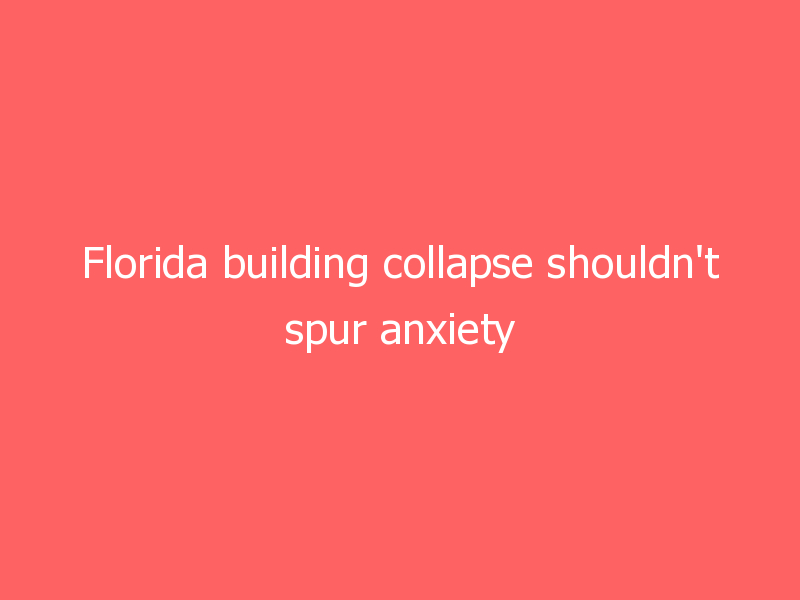Farro Tofighi, a structural engineer with DeSimone Consulting Engineers, poses in the DeSimone Las Vegas office Wednesday, July 14, 2021.
Sunday, July 18, 2021 | 2 a.m.
Farro Tofighi, a structural engineer who has worked on the some of the most well-known high-rises on the Las Vegas Strip, has a message for anyone here who worries about building safety in the wake of the condo tragedy that happened in Florida last month.
“Something like that rarely happens,” said Tofighi, the managing principal at DeSimone Consulting Engineers, a global firm with offices in Las Vegas, New York City and Miami among other cities. “I don’t believe people here have any reason to worry.”
Nearly 100 have been found dead in the rubble of a Surfside, Fla., condominium building that collapsed last month. Others are still missing and presumed dead.
Hours after the tragedy, Tofighi started receiving phone calls from concerned friends and colleagues around the nation wondering if their building could also be at risk.
“It boggles my mind that it happened,” said Tofighi, who moved to Las Vegas in the early 1990s to work on the construction of MGM Grand. “If you’re a condo owner or a building owner in Las Vegas, I wouldn’t worry about your building coming down. We design buildings well.”
Tofighi should know. He’s had a significant hand in the construction of the Cosmopolitan, Treasure Island, Circa Las Vegas and Resorts World.
Since he has also worked on buildings in South Florida, Tofighi said he knows that the climate there — rife with moisture near a major supply of salt water — can be hard on buildings.
He said it was unusual for a building “at rest,” with construction completed and sans any type of natural disaster like a hurricane, to collapse on top of itself.
While some local guidelines can be different on a case-by-case basis, Tofighi said new construction in the United States generally follows the guidelines set forth by the International Code Council, a collection of building code standards that are updated every three years.
Those guidelines — known as I-Codes — are followed by the three main local jurisdictions where high-rise buildings are found in the valley. Those, of course, are Las Vegas, Clark County and Henderson.
Once a building goes up and a certificate of occupancy is issued, according to Las Vegas and Henderson sources, there are no more scheduled structural integrity checks by the municipalities unless a specific issue or complaint arises.
For instance, because the 35-story Circa building in downtown Las Vegas was completed last year, city inspectors aren’t required to continually check up on its structural integrity.
Clark County officials did not make a building inspection official available for this story, though it does have a team of “structural inspectors” who work to certify projects in its jurisdiction, according to its website.
Most of the tall buildings along the Las Vegas Boulevard resort corridor — including the massive Resorts World project — fall under the county’s jurisdiction.
“In the U.S., we all use the same code, and it’s one of the best standards in the world,” Tofighi said. “Even if you’re not an innovative engineer and you just use the code, the building should be good. In general, structural engineers are conservative people — we’re responsible for life safety. When you sign onto the drawings, you have your neck out there.”
In Southern Nevada, there aren’t hurricanes, tornados or tsunamis, and extreme heat doesn’t have much of an effect on concrete or steel, Tofighi said.
The soil here — much of it is of a hard caliche-type variety — is also quite conducive for successful building, but it is an area that has some earthquake risks.
A magnitude 5.9 earthquake did rattle areas several hours north of Las Vegas near the California-Nevada border earlier this month, an occurrence that is somewhat common for the area.
It’s not unusual for people in places like Carson City or Reno to feel the effects of an earthquake, though it’s less common in the Las Vegas Valley.
That said, Majid Pakniat, assistant director of building and fire safety for Henderson, did say that it’s possible that Las Vegas to someday be in the path of a large earthquake that could cause problems.
Pakniat would know — he worked in the Los Angeles city department that was responsible for earthquake tracking in the 1980s and 1990s and was on staff when the deadly Northridge earthquake struck in 1994.
“The main concern we have in Nevada is seismic because of the region we’re in,” Pakniat said. “When we view the structure plans for a building, concern about seismic activity is very important. So far, thank God, we haven’t seen any major earthquakes in our area. Is it going to happen one day? Maybe. We don’t know when because it really isn’t possible to predict an earthquake. When the Northridge earthquake hit, we had no idea it was coming.”
Like in the other main local jurisdictions, when a large building is being planned in Henderson, engineers will check for how much pressure a structure can handle from a gravity load standpoint — people, furniture, pretty much anything inside a building — and from a lateral load perspective.
Lateral loads are pressure from high winds or earthquakes, Tofighi said.
In high-wind situations, tall buildings are designed to be able to move and sway to a limited degree.
During a windstorm, therefore, somebody in a high-rise building might feel the building move slightly, but it’s nothing to worry about. It’s all part of the design of the building.
“The building in Florida was a residential high-rise and traditionally we haven’t seen a lot of those types of buildings in Las Vegas,” Tofighi said. “We have more of them now, including some at CityCenter. Our buildings here in Las Vegas aren’t going to fall down, but I would recommend regular maintenance. People shouldn’t ignore obvious signs of deterioration that might or might not end up being a problem.”
One of the most high-profile Las Vegas construction failures in recent memory happened over a decade ago when construction on the planned 47-story Harmon condominium building within the CityCenter development on the Strip was stopped by inspectors.
The inspectors found that steel used on the building’s first 26 stories wouldn’t likely support the remaining 22 floors. What was completed of the building was eventually razed, though the CityCenter development went on to open in 2009.
“That building had some flaws, which the inspectors and engineers discovered during construction,” Tofighi said. “But it was actually safe up to where it was built, so they didn’t have to take it down. It would have required a lot of modification to add the extra floors, which the owner chose not to do. Publicity and perception can become a problem in a case like that. They had to think about whether a person would buy a condo in a building that everyone was saying wasn’t safe.”
Like everyone else who has paid attention to the national news cycle during the past few weeks, Dayna Roselli is aware of the condo collapse that happened near Miami.
Roselli lives more than 20 stories up in one of the Turnberry Towers condo buildings in Las Vegas, but said she’s not worried about the structural integrity of the place she calls home.
“I’m aware of what happened, but it’s not something that I think about happening here,” Roselli said. “It’s so rare for something like that to happen, and I know that the people at Turnberry Towers keep up with maintaining and checking the units. I feel confident that I would notice if something wasn’t right. I feel completely safe here.”
As investigators and local and national officials continue to piece together the puzzle that is the collapse of the Surfside building, Tofighi said those in the structural engineering field will learn from it as answers are discovered.
It’s all part of an ever-evolving field. Besides, he said, the buildings in the valley are young and there aren’t near the environmental factors here that are found in places like Florida.
“A 40-year-old building in Florida would be the equivalent of maybe an 80- or 100-year-old building here,” Tofighi said. “I do hear people feeling nervous here, but there’s no need for that. Could a plane crash? Yes, but that doesn’t happen very often. Yes, anything can happen in this world, but people shouldn’t be worried about what happened in Florida happening here.”
Originally found on Read More







